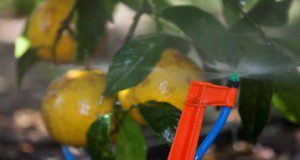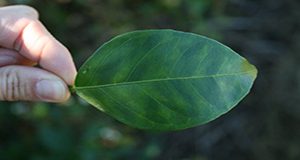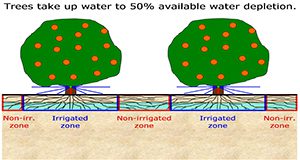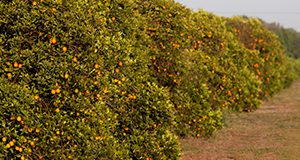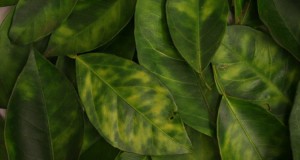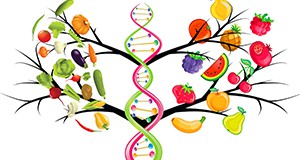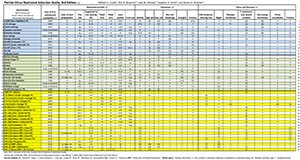To improve production of huanglongbing (HLB) affected trees, nutrition, irrigation, and soil pH should be considered together, because each can influence the efficacy of the others in overcoming the effects of HLB on tree performance. This two-sided poster published by the UF/IFAS Horticultural Sciences Department through the UF/IFAS Citrus Research and Education Center was written by Tripti Vashisth, Davie Kadyampakeni, and Jamie D. Burrow.
https://edis.ifas.ufl.edu/hs1367
Tag: Citrus Greening (Huanglongbing)
Citrus Tree Care for the Home Gardener in the HLB Era
Since the early 2000s, growing citrus has become much more challenging due to plant disease pressure. HLB is the most devastating disease affecting Florida citrus, and threatens the survival of the citrus industry. This 4-page document describes citrus growth and care while managing the risk of an HLB infection. Written by Jamie D. Burrow, Tripti Vashisth, Megan Dewdney, and Brooke Moffis and published by the UF/IFAS Plant Pathology Department, November 2017.
http://edis.ifas.ufl.edu/pp336
Irrigation Management of HLB-Affected Trees
Water is a limiting factor in Florida citrus production due to non-uniform rainfall distribution and the low water-holding capacity of our sandy soils. Because periods of low rainfall coincide with critical stages of citrus production, additional irrigation is necessary to reduce the negative effects of water stress. This 6-page document covers recent findings on water use of trees affected by citrus greening and the impact this would have on irrigation management considerations. Written by Davie Kadyampakeni, Kelly Morgan, Mongi Zekri, Rhuanito Ferrarezi, Arnold Schumann, and Thomas A. Obreza and published by the UF/IFAS Department of Soil and Water Sciences, October 2017.
http://edis.ifas.ufl.edu/ss659
Citrus Irrigation Management
 The chapter on irrigation management of citrus is largely taken from guidelines provided in SL253 on trees prior to Huanglongbing (HLB) prevalent conditions. A section has been added to cover recent findings on water use of trees affected by HLB and the impact this would have on the irrigation management considerations. This 6-page fact sheet discusses water supply, allowable soil water depletion, irrigation scheduling, soil moisture measurement, water budgeting, smartphone apps, irrigation strategies to improve nutrient uptake and reduce leaching, and irrigation management considerations for HLB-affected trees. Written by Davie Kadyampakeni, Kelly Morgan, Mongi Zekri, Rhuanito Ferrarezi, Arnold Schumann, and Thomas Obreza, and published by the UF/IFAS Soil and Water Sciences Department, September 2017.
The chapter on irrigation management of citrus is largely taken from guidelines provided in SL253 on trees prior to Huanglongbing (HLB) prevalent conditions. A section has been added to cover recent findings on water use of trees affected by HLB and the impact this would have on the irrigation management considerations. This 6-page fact sheet discusses water supply, allowable soil water depletion, irrigation scheduling, soil moisture measurement, water budgeting, smartphone apps, irrigation strategies to improve nutrient uptake and reduce leaching, and irrigation management considerations for HLB-affected trees. Written by Davie Kadyampakeni, Kelly Morgan, Mongi Zekri, Rhuanito Ferrarezi, Arnold Schumann, and Thomas Obreza, and published by the UF/IFAS Soil and Water Sciences Department, September 2017.
http://edis.ifas.ufl.edu/ss660
Managing the Health and Productivity of HLB-Affected Groves
After years of extensive research from across the world, we still do not have a cure for HLB; however, we have learned a lot about this disease, the plant’s response to the disease, and the disease vector. Based on scientific and observational information gathered in the last decade, a number of tools and strategies are currently available for growers to maintain the health and productivity of HLB-affected trees. This four-page fact sheet will shed light on these currently available horticultural inputs and practices that can be implemented immediately by growers to maintain and improve citrus tree health.Written by Tripti Vashisth and published by the Horticultural Sciences Department.
http://edis.ifas.ufl.edu/hs1288
Huanglongbing (HLB; citrus greening) and Nutrient Deficiency Identification

Huanglongbing (HLB) is a bacterial disease that is spread by an insect, the Asian citrus psyllid. This two-page fact sheet, which is best viewed as a PDF, http://edis.ifas.ufl.edu/pdffiles/PP/PP32800.pdf, explains how to tell the difference between HLB symptoms and symptoms from nutrient deficiencies. Written by T. Vashisth, M.M. Dewdney, and J.D. Burrow and published by the Plant Pathology Department.
http://edis.ifas.ufl.edu/pp328
Frequently Asked Questions About Huanglongbing (HLB; citrus greening) for Homeowners
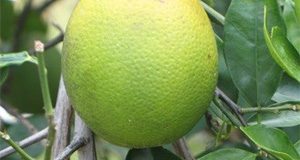
Huanglongbing (HLB), also known as citrus greening, is a serious bacterial disease that affects citrus in Florida. Florida residents enjoy growing citrus for a variety of reasons, but growing citrus in today’s disease climate is not an easy task. This seven-page document is designed to help Master Gardeners and homeowners answer commonly asked questions about HLB. Written by Brooke L. Moffis, Jamie D. Burrow, Megan M. Dewdney, and Michael E. Rogers and published by the Plant Pathology Department.
http://edis.ifas.ufl.edu/pp326
Huanglongbing (HLB; citrus greening) Leaf and Fruit Symptom Identification
Huanglongbing (HLB), commonly known as citrus greening, is a bacterial disease that affects all citrus varieties. This two-page fact sheet describes the leaf and fruit symptoms of HLB. Written by Jamie D. Burrow and Megan M. Dewdney and published by the Department of Plant Pathology.
http://edis.ifas.ufl.edu/pp327
Citrus Greening (Huanglongbing; HLB) Blight and Tristeza Comparison Identification Sheet
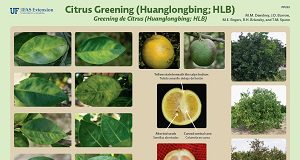 This document is a two-page illustrated identification sheet for Citrus Greening that includes a comparison chart for Citrus Greening, Blight and Tristeza.
This document is a two-page illustrated identification sheet for Citrus Greening that includes a comparison chart for Citrus Greening, Blight and Tristeza.
http://edis.ifas.ufl.edu/pp263
Impact of Citrus Greening on Citrus Operations in Florida
Florida is the largest orange-producing state in the United States and the third largest orange producer in the world, but the Florida citrus industry and its position in the global citrus market are being jeopardized by a bacterial disease known as citrus greening or Huanglongbing (HLB). HLB hurts the vascular systems of citrus trees and prevents them from absorbing nutrients. The disease reduces yields, leads to smaller, lower-quality fruit, kills trees, and increases farmers’ production costs. First found in Florida in 2005, HLB has spread rapidly across the state.
As of January 2016, there is neither a cure nor an economically viable option for managing HLB-infected trees. Since HLB was first found in 2005, orange acreage and yield in Florida have decreased by 26% and 42%, respectively. Orange production dropped from 242 million to 104.6 million boxes in 2014. Even though the industry acknowledges that HLB has reached epidemic proportions across the state, estimates of the level of infection and its impact on citrus operations are scarce. This 4-page article written by Ariel Singerman and Pilar Useche and published by the Food and Resource Economics Department presents the first growers’-survey-based estimates of both the level of HLB infection in Florida and the impact of HLB on citrus operations in Florida.
http://edis.ifas.ufl.edu/fe983
Plant Diagnostic Clinic and HLB Lab
The Plant Pathology program at the UF/IFAS Southwest Research and Education Center is the state and local resource for plant diagnostic services, including HLB (Huanglongbing, or citrus greening) detection, and for insect identification. This brochure covers the center’s history, instructions for sending samples to the HLB lab, answers to frequently asked questions, and center hours and contact information. Written by Pamela Roberts, Shea Teems, Joubert Fayette, and Jamie Burrow, and published by the UF Department of Plant Pathology, July 2015.
http://edis.ifas.ufl.edu/pp319
Florida Citrus Rootstock Selection Guide, 3rd Edition
Information about citrus rootstocks has become an important part of understanding and managing citrus greening (Huanglongbing or HLB). This selection guide covers 20 characteristics of 45 citrus rootstocks and explains its methodology in detail. This 3-page fact sheet was written by William S. Castle, Kim D. Bowman, Jude W. Grosser, Stephen H. Futch, and James H. Graham and published by the UF Department of Horticultural Sciences, May 2015.
http://edis.ifas.ufl.edu/hs1260
Tree Assistance Program for Florida Citrus Greening
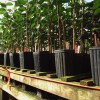 In September 2014, the USDA Farm Service Agency (FSA) announced additional support for commercial Florida citrus growers to manage greening, in the form of an expansion of the Tree Assistance Program (TAP). The original program assisted growers in the event the loss occurred within a single year due to a natural disaster such as a hurricane. The expanded TAP recognizes citrus greening (Huanglongbing, or HLB). The program provides growers cost-sharing financial assistance to replace trees that meet a mortality criterion within a time period of up to six years. This 4-page fact sheet describes eligibility requirements, how the program works, and how to calculate payments. Written by Ariel Singerman and Fritz Roka, and published by the UF Department of Food and Resource Economics, April 2015.
In September 2014, the USDA Farm Service Agency (FSA) announced additional support for commercial Florida citrus growers to manage greening, in the form of an expansion of the Tree Assistance Program (TAP). The original program assisted growers in the event the loss occurred within a single year due to a natural disaster such as a hurricane. The expanded TAP recognizes citrus greening (Huanglongbing, or HLB). The program provides growers cost-sharing financial assistance to replace trees that meet a mortality criterion within a time period of up to six years. This 4-page fact sheet describes eligibility requirements, how the program works, and how to calculate payments. Written by Ariel Singerman and Fritz Roka, and published by the UF Department of Food and Resource Economics, April 2015.
http://edis.ifas.ufl.edu/fe966
Floridians' Perceptions of GMOs: GMOs and Florida Citrus
 Worldwide and in Florida, food-related issues such as food safety, food security, and use of new food technologies continue to be top concerns. Among the food-related issues are concerns about consuming the products from transgenic plants, often referred to as “GMOs.” This 4-page fact sheet is intended to help Extension faculty understand public perceptions regarding the use of genetic engineering to combat citrus greening. Extension faculty can use this understanding of public perceptions as they develop and deliver programming for clientele. Written by Nicole M. W. Dodds, Laura M. Gorham, and Joy N. Rumble, and published by the UF Department of Agricultural Education and Communication, October 2014.
Worldwide and in Florida, food-related issues such as food safety, food security, and use of new food technologies continue to be top concerns. Among the food-related issues are concerns about consuming the products from transgenic plants, often referred to as “GMOs.” This 4-page fact sheet is intended to help Extension faculty understand public perceptions regarding the use of genetic engineering to combat citrus greening. Extension faculty can use this understanding of public perceptions as they develop and deliver programming for clientele. Written by Nicole M. W. Dodds, Laura M. Gorham, and Joy N. Rumble, and published by the UF Department of Agricultural Education and Communication, October 2014.
http://edis.ifas.ufl.edu/wc182
Citrus Greening and Citrus Tree Planting in Florida
 This 4-page fact sheet examines the impact of the presence of citrus greening on new tree plantings in the Florida citrus industry. Sweet oranges are by far the most important citrus variety grown in Florida, so the analysis is limited to sweet orange plantings. Because citrus greening impacts citrus producers through reduced yield, increased mortality, and increased cost of production, it is expected that the presence of citrus greening has had an adverse impact on the willingness of growers to invest in new trees. Written by Thomas H. Spreen and Jean-Paul Baldwin, and published by the UF Department of Food and Resource Economics, January 2014.
This 4-page fact sheet examines the impact of the presence of citrus greening on new tree plantings in the Florida citrus industry. Sweet oranges are by far the most important citrus variety grown in Florida, so the analysis is limited to sweet orange plantings. Because citrus greening impacts citrus producers through reduced yield, increased mortality, and increased cost of production, it is expected that the presence of citrus greening has had an adverse impact on the willingness of growers to invest in new trees. Written by Thomas H. Spreen and Jean-Paul Baldwin, and published by the UF Department of Food and Resource Economics, January 2014.
http://edis.ifas.ufl.edu/fe937
Economic Impacts of Citrus Greening (HLB) in Florida, 2006/07-2010/11 (FE903)
 Since 2006, the bacterial disease citrus greening has cost Florida’s economy an estimated $3.636 billion in lost revenues and 6,611 jobs by reducing orange juice production, according to the study reported in this 5-page fact sheet written by Alan W. Hodges and Thomas H. Spreen and published by the UF Department of Food and Resource Economics, January 2012.
Since 2006, the bacterial disease citrus greening has cost Florida’s economy an estimated $3.636 billion in lost revenues and 6,611 jobs by reducing orange juice production, according to the study reported in this 5-page fact sheet written by Alan W. Hodges and Thomas H. Spreen and published by the UF Department of Food and Resource Economics, January 2012.
http://edis.ifas.ufl.edu/fe903
UF/IFAS press release: http://news.ufl.edu/2012/01/24/greening-cost/
The Effects of Huanglongbing on Florida Oranges (FSHN1108/FS169)
This tri-fold brochure offers commercial citrus growers and other stakeholders succinct details about the effects of HLB, and presents important facts of HLB’s history in Florida, illustrated descriptions, and details regarding HLB’s effects on fruit yield, appearance, and quality. Includes author contact information. Written by Michelle Danyluk, Timothy M. Spann, Russell Rouseff, Renée M. Goodrich-Schneider, and Charlie Sims, and published by the UF Department of Food Science and Human Nutrition, January 2011.
http://edis.ifas.ufl.edu/fs169
EENY475/IN858 An Asian citrus psyllid parasitoid Tamarixia radiata (Waterson) (Insecta:Hymenoptera:Eulophidae)
EENY475, a 5-page illustrated fact sheet by Rajinder S. Mann and Lukasz L. Stelinski, is part of the Featured Creatures collection. It describes this effective parasitoid of the Asian citrus psyllid, a vector for Huanglongbing disease in citrus — distribution, description, life cycle, hosts, and biological control. Includes references. Published by the UF Department of Entomology and Nematology, June 2010.
http://edis.ifas.ufl.edu/in858
EENY033/IN160 Asian Citrus Psyllid, Diaphorina citri Kuwayama (Insecta: Hemiptera: Psyllidae)
Revised! EENY033, an 8-page illustrated fact sheet by F.W. Mead, is part of the Featured Creatures collection. It describes this serious pest of citrus which is a vector for citrus greening disease or Huanglongbing — identification, distribution, description, life history, damage, and management. Includes references. Published by the UF Department of Entomology and Nematology, July 2010.
http://edis.ifas.ufl.edu/in160
FE823 The Incidence of Greening and Canker Infection in Florida Citrus Groves from September 2007 through August 2008
FE823, a 5-page report by Robert A. Morris, Candice Erick, and Mark Estes, presents the results of a grower-based survey to estimate the degree of greening infection currently present in Florida citrus groves. Published by the UF Department of Food and Resource Economics, December 2009.
http://edis.ifas.ufl.edu/FE823
